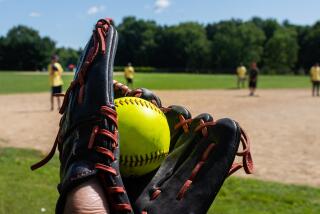The Great Bat Debate Continues
- Share via
OAK LAWN, Ill. — Bill Kalant never had a chance to get out of the way of the baseball that put him, as doctors told his father, “on the cliff of death.”
The pitcher’s parents, sitting a few feet away, heard the familiar “ping” of ball hitting metal bat, followed an instant later by a sickening thud, but never caught a glimpse of the ball. The position of Kalant’s body -- still bent over from throwing a pitch, his glove near the ground -- led coaches to conclude they’d never witnessed a ball hit so hard.
Moments later, the 16-year-old Oak Lawn High School sophomore lost consciousness. Even before he came out of a coma two weeks later, he was thrust into an emotional debate over the use of aluminum bats.
At issue is whether aluminum bats have made baseball unnecessarily dangerous. On one side are those who say baseballs fly off those bats much faster than they do wood bats and have led to severe injuries and, in a handful of cases, death. On the other side are those who say balls travel no faster off aluminum bats and that there is no evidence they put players at greater risk of injury.
Around the country, after decades of using aluminum bats, a small but growing number of college and high school leagues are switching to wood bats.
In Illinois, where Kalant was injured and a college pitcher had his skull fractured last year, the state high school association hopes to put wood bats in the hands of players in several conferences next year to study injuries, run production and costs. And in Chicago, the coordinator of the public school district’s high school league says he’s seen enough of aluminum bats and wants to switch to wood as soon as possible.
“These aluminum bats have been nothing but bad for baseball,” said Eddie Curry, who oversees Chicago’s public school league. “Some of these kids are afraid stiff of line drives coming back to them, afraid of playing baseball because of aluminum bats.”
Earlier this week, an American Legion team in Montana forfeited two games because its opponent would not play with wood bats. The Miles City Mavericks haven’t faced aluminum bats in the nearly three years since pitcher Brandon Patch died when a line drive off an aluminum bat struck his head.
Starting next season in North Dakota, every high school team will use wood bats -- a move officials say was prompted by discussions that started after Patch’s death.
There’s no question metal bats have changed the game. Batting averages are higher and there are more home runs in games in which aluminum bats are used.
For example, this season in 31 conference games using wood bats, Franklin Pierce College in New Hampshire hit 10 home runs -- compared with 52 homers in 29 nonconference games using aluminum bats.
“The bats, they’re trampolines,” said the team’s coach, Jayson King. “The ball jumps off the bat.”
It’s the same story in the Great Lakes Valley Conference, a Division II college conference that switched to wood bats in 1998.
“In 1980 with aluminum bats, we had 104 home runs and this year the most home runs in our conference was 14,” said Irish O’Reilly, the coach at Lewis University in suburban Chicago.
“If your team is using wood and their team is using aluminum, you can’t beat them,” he said. “It’s like David versus Goliath.”
A big reason is that aluminum bats have larger sweet spots, the area that produces hard-hit balls.
Curry said part of his push for wood bats is that he thinks they improve players’ batting skills -- a sentiment shared by many coaches. Ralph Dalton, the coach at St. John the Baptist high school in West Islip, N.Y, noticed the difference when his league switched to wood bats this season.
“It’s made them better hitters and better players,” Dalton said.
Curry also believes wood bats give players a better chance at making it to pro baseball, which uses wood. And Dalton said one thing is clear: Professional scouts love to watch leagues that use wood bats.
Are line drives off aluminum bats really traveling faster than line drives off wood bats? Are they making baseball more dangerous?
The answer to the first question, say bat makers and others, is that they used to travel faster -- but don’t any more. After the 1998 College World Series, in which USC beat Arizona State 21-14, the NCAA took some pop out of the bats by setting a 97 mph speed limit at which the ball can come off the bat.
The second question is tougher to answer. Even though aluminum bats have been widely used since the 1970s, there is scant evidence one way or the other about whether they’ve added danger to the game.
Statistics, particularly on the high school level, on batted ball injuries are hard to come by because, officials say, there isn’t an adequate injury reporting system.
Further, what statistics are available are incomplete. For example, the U.S. Consumer Product Safety Commission found that between 1991 and 2001 there were 17 players killed by batted balls. But while eight involved metal bats and two involved wood bats, in seven instances the kind of bat wasn’t known.
With the pending switch to wood bats in North Dakota, and a study underway comparing injuries among college players using aluminum bats to those playing in wood bat summer leagues, there is hope for some scientific data.
But many coaches and officials insist balls fly off aluminum bats faster than they do wood bats.
“The exit velocity off aluminum bats is dangerous,” said Jonathan Harper, associate commissioner of the Northeast-10 Conference, one of the few college conferences in the nation that uses wood bats. “I don’t care what it’s [exit velocity] set at. It’s still metal hitting the ball instead of wood.”
More to Read
Go beyond the scoreboard
Get the latest on L.A.'s teams in the daily Sports Report newsletter.
You may occasionally receive promotional content from the Los Angeles Times.










